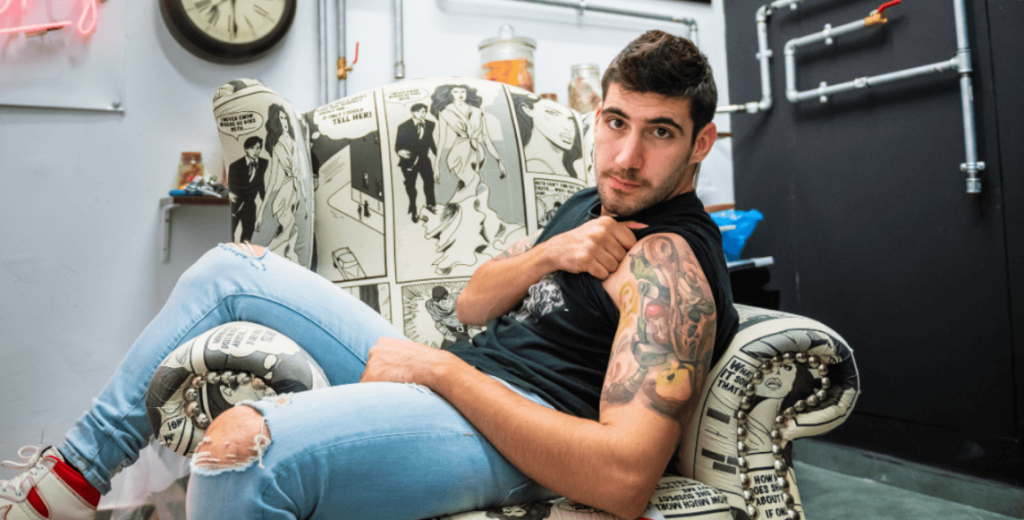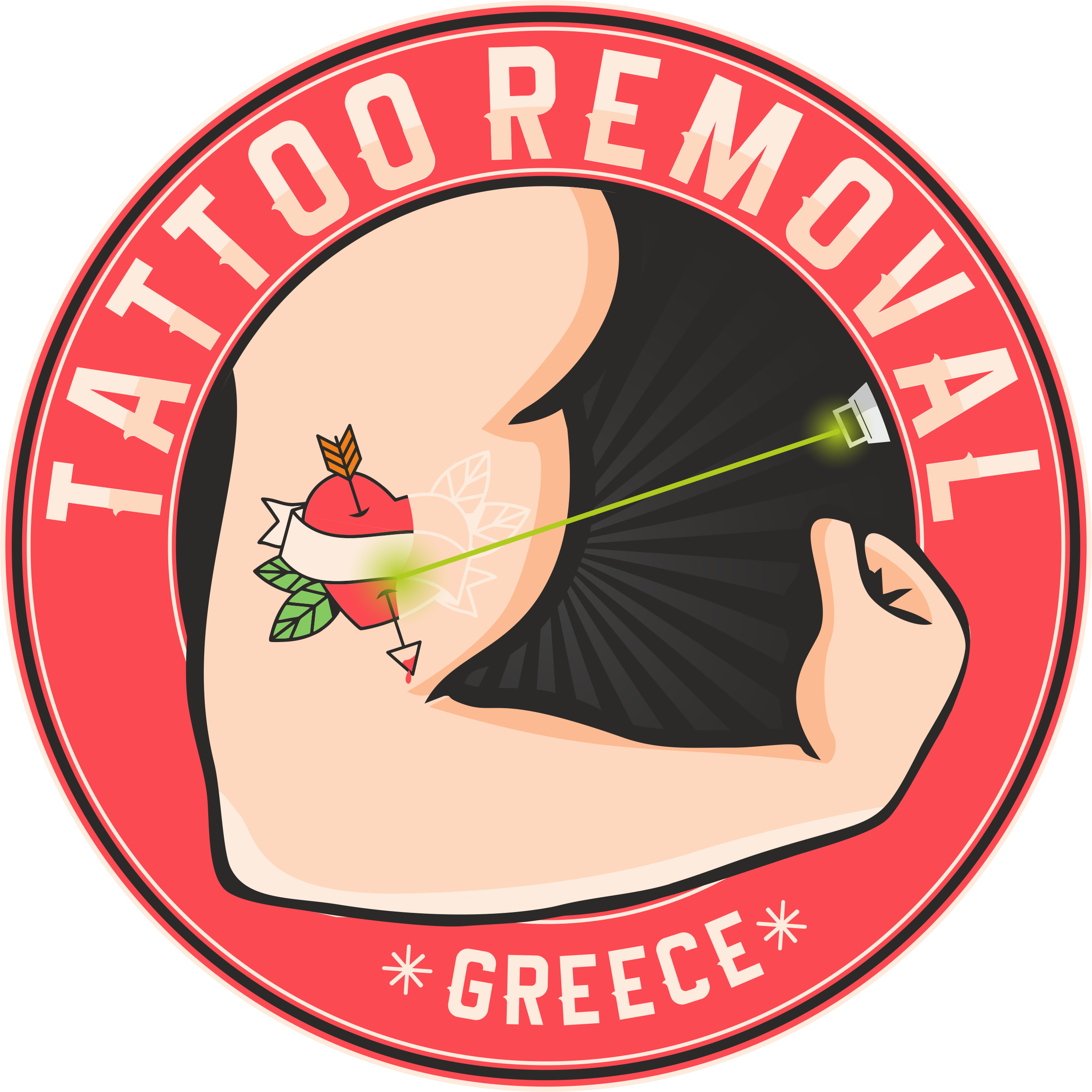
12 Tips
FROM PANOS GEORGOULIAS
The excellent results we offer for the minimum amount of sessions is based on your judgment. The “good tattoo” public is particularly attentive regarding the quality of the results. This happens because demands for a good tattoo are just as high as for the result of a successful removal with smooth skin and no scars.
1
When did laser as a medium start to be integrated in the tattoo space?
The first laser tattoo removal session took place in 1967, when Dr Leon Goldman used laser, at a very slow pulse at the time, on some client of his. However, these first laser treatments were not as safe or effective as the technicians had hoped for, so there had to be more research and development to improve machine technology. At older times, people used painful and often more dangerous methods to remove their tattoos, such as various chemicals or other objects with a “rough” surface, so that with the friction they could scratch some layers of skin to get to the layer with the tattoo ink. Another classic method they used was dermabrasion, which took place and still takes place today with a dremel-type object. This method increases the likelihood of infections as well as scars on the skin.
2
Lets make the abilities of this medium a bit clearer.
The lasers that medical experts have settled on in recent years have been Q-Switched lasers, which came out in the market in the 1990s. These lasers produce a gigantic formation of pulses that have high energy levels and are powerful enough to deal with different wavelengths to break down the tattoo ink. Q-Switched lasers are still used today in many tattoo removal centers and many times without good results. They often require many sessions, without offering a satisfactory result. Now we have reached the Picosecond technology, which can remove a tattoo in fewer sessions, much more painlessly and naturally and, of course, without injuring the skin, which means that it will not scar while healing.
3
How does the laser tattoo removal process work and how often can a person do sessions?
With our Pico machine (which is the most advanced that exists globally at the moment) the laser breaks down the ink to smaller particles. The energy pulse is “surgical”, very short (in nano or pico seconds) and we can liken it to hitting the chisel with a hammer on the marble.
At the same time, the laser locally activates the concentration of phagocytes (the body's defence cells) around the particles. The ink particles created are “eaten” by the phagocytes and removed through natural pathways of the body in a matter of weeks. Essentially, the procedure puts in motion a natural process of removing the foreign body from our skin, giving the stimulation for it to happen at a much faster speed because of the Pico technology compared to the older technology in Q-Switched machines. The sessions take place at least every 35 days. After the session the skin may have a mild irritation and we give aftercare instructions for the next few days. In the coming weeks, the tattoo starts to “disappear” slowly and steadily as the ink is removed.
Ταυτόχρονα το λέιζερ ενεργοποιεί τοπικά τη συγκέντρωση φαγοκυττάρων (κυττάρων άμυνας του οργανισμού) γύρω από τα κομμάτια. Τα θραύσματα της χρωστικής που σχηματίζονται «τρώγονται» από τα φαγοκύτταρα και απομακρύνονται μέσω φυσικών οδών του οργανισμού σε διάστημα εβδομάδων. Δηλαδή, στην ουσία η θεραπεία κινητοποιεί μια φυσική διαδικασία απομάκρυνσης του ξένου σώματος από το δέρμα μας, δίνοντας το ερέθισμα βεβαίως για να γίνει με πολλαπλάσια ταχύτητα λόγω της τεχνολογίας Pico σε σχέση με την παλαιότερη τεχνολογία των μηχανημάτων Q-Switched. Οι συνεδρίες γίνονται το λιγότερο ανά 35 μέρες. Μετά τη συνεδρία το δέρμα έχει έναν ήπιο ερεθισμό και δίνονται οδηγίες περιποίησης για λίγες μέρες μετά. Τις αμέσως επόμενες εβδομάδες το tattoo αρχίζει να «εξαφανίζεται» αργά και σταθερά καθώς η χρωστική απομακρύνεται.
4
Is the removal result influenced by how a tattoo artist has inked the tattoo?
Of course it plays a role! Even though I grew up in an environment with my father as a doctor, I had many discussions with colleagues of his regarding the process of removing a tattoo. Many times the knowledge of a doctor who is not familiar with the tattoo field and the needle techniques is inadequate for a client to have a perfect result without scarring, without spots and his skin completely pristine like there was never a tattoo there. Most people visit Tattoo Removal Greece because they trust my work, my technique and my choices all these years on the topic of “tattoo” which I’m evolving every day that passes.
5
Can color tattoos be removed?
The truth is, as I said, that the way a tattoo is inked plays an important part in the removal process. In black and white tattoos the shading is softer on the skin and it can be removed even from the first session. Although our machine has heads that detect the rays of colors such as red, blue, green and yellow, it often takes more sessions to remove them than black and white tattoos.
6
I’ve heard that tattoo removal hurts more than the inking. How true is that?
Look, to be completely honest with you, I’ll say that it’s relevant. Of course the creation of a tattoo may take 6-7 painful hours, while the removal of the same tattoo takes 10-15 minutes. A tattoo removal session αφαίρεσης very rarely exceeds 45 minutes. We also have special creams that we recommend to clients, which reduce pain by 80-90% compared to someone doing the session without the cream. The good thing with the issue of removals and the technology we use in our space (clinic) is that the machines we have are the most advanced at the moment in the world, let alone in Greece, and that makes things definitely more tolerable. αρκετά πιο ανεκτικά σίγουρα.
7
How did you decide to incorporate tattoo removal at Polis Decay Tattoo-Gallery? Isn’t it a counter-role?
I love tattooing and everything that is related to it much more than many tattooers out there. I never saw it as money, like many big studios in Greece and abroad do. The staff I have in the laser space are people and doctors with long experience in the removal field for many years now, and I worked with them even before I added it to my shop. When I created the vision for my shop, about how I wanted it to be in the times that we live in, I wanted it to be a very different experience in tattoo from what people are used to seeing until today. What I do I want to do well, so I wouldn’t open a tattoo removal space that wouldn’t have the best and most advanced equipment that exists. We spent several years observing the advancements in this field so that we could settle on the best machine combined with our technique and our experience in its operation. There are many ignorant tattooers, businessmen and doctors who pour endless amounts of money into advertising and buying a very expensive machine without knowing how to operate it and judge what kind of treatment each tattoo needs and what the skin of the client is like. To us it's all about our work, word of mouth advertising and how happy our clients are left after their session.
8
What do you think about the rumor that tattoo removal is the profession of the future?
As I said earlier, I love all the aspects of tattooing. That’s what they said when I began tattooing 11 years ago and you can see that I keep evolving in this field. Because some things become “trends” due to timing and the age we live in doesn’t mean that for me “it’s the future”. As much as people love tattoos, they also want to remove the unsatisfactory ones so that they can get new ones on top. At least that’s what they come for most often at Tattoo Removal Greece.
9
How likely is it that we won’t get the tattoo 100% removed? Is there a likelihood for spots, scars, etc, on the skin?
It’s not a matter of probabilities. There are many things that play a part in tattoo removal. There are tattoos that have formed a keloid (a rough textured scar) which, when it’s extensive, we’d rather not take on the case, or we ask the client to have the responsibility about whether he’d like to do a session to see how it goes. Apart from the quality of the machine as we mentioned, the operator definitely plays a part, as well as his experience in removals. With our experience, we can make some assumptions about the depth of a tattoo, the ink used, as well as for how many sessions are needed before someone sees the desired results. Doctors usually have no idea about all this and this is the reason people come to us. In our space clients can remove tattoos quickly and efficiently at a low cost.
10
Was there a client who did not have the result he wanted? How do you deal with such a case?
Until now no client has ever left unsatisfied, compared to other shops or clinics from which people come to us because they don’t see the results they want in the promised time frame. We are always honest in everything that we do. This is what has gotten us where we are. If there is a possibility that a tattoo cannot be removed we will inform the client before we begin the removal process, even though most of the time we have a comprehensive view to answer all his questions accurately after the first laser session. It’s good for people to know that tattoos rarely go away after one session. It’s something that needs patience and there’s a possibility that three or four sessions will be needed to make the skin spotless like it was before the tattoo.
11
Can laser prepare the area for a new tattoo in the same spot?
Of course! There are many clients who come to us for this reason. A few years ago you could cover your old tattoo with color, mainly black, something that wasn’t aesthetically pleasing for many people. There were many times, in fact, that many people were fooled by tattooers because they told them that they could do a cover up that ended up being a smudge on the already existing badly inked old tattoo. We have also had cases where, while their skin had rough areas and it seemed like there was no hope to save the tattoo, by doing their sessions regularly with our machine, the skin reverted to its initial state (regeneration).
12
Say a message you would like to pass on to everyone out there for these difficult days. What do you think we're going to see after all this?
I think everyone is aware of the situation out there with the virus. People in our neighboring countries are being lost every day and it's certainly not pleasant at all. Because I live in Greece I don't know how what many people are saying sounds: "we are doing quite well regarding deaths". The truth is I don't know what can be in store for all of us after this situation. It makes me very sad that people are being laid off every day and companies are closing down. I want to be optimistic and see what good can come out of staying cooped up in our house for so many days. I wish the best for everyone!
